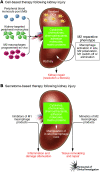Macrophage diversity in renal injury and repair
- PMID: 18982158
- PMCID: PMC2575702
- DOI: 10.1172/JCI36150
Macrophage diversity in renal injury and repair
Abstract
Monocyte-derived macrophages can determine the outcome of the immune response and whether this response contributes to tissue repair or mediates tissue destruction. In addition to their important role in immune-mediated renal disease and host defense, macrophages play a fundamental role in tissue remodeling during embryonic development, acquired kidney disease, and renal allograft responses. This review summarizes macrophage phenotype and function in the orchestration of kidney repair and replacement of specialized renal cells following injury. Recent advances in our understanding of macrophage heterogeneity in response to their microenvironment raise new and exciting therapeutic possibilities to attenuate or conceivably reverse progressive renal disease in the context of fibrosis. Furthermore, parallels with pathological processes in many other organs also exist.
Figures



References
-
- Takahashi K., Yamamura F., Naito M. Differentiation, maturation, and proliferation of macrophages in the mouse yolk sac: a light-microscopic, enzyme-cytochemical, immunohistochemical, and ultrastructural study. J. Leukoc. Biol. 1989;45:87–96. - PubMed
-
- Morioka Y., Naito M., Sato T., Takahashi K. Immunophenotypic and ultrastructural heterogeneity of macrophage differentiation in bone marrow and fetal hematopoiesis of mouse in vitro and in vivo. J. Leukoc. Biol. 1994;55:642–651. - PubMed
Publication types
MeSH terms
Grants and funding
LinkOut - more resources
Full Text Sources
Other Literature Sources
Medical

